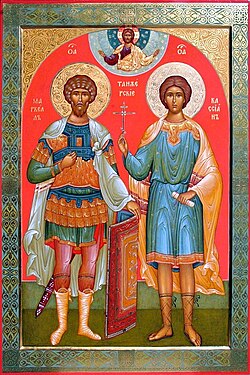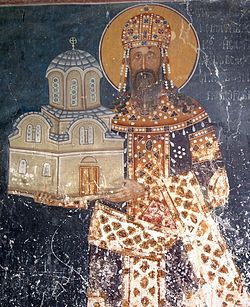Top Qs
Timeline
Chat
Perspective
October 30 (Eastern Orthodox liturgics)
From Wikipedia, the free encyclopedia
Remove ads
October 29 - Eastern Orthodox liturgical calendar - October 31

All fixed commemorations below are observed on November 12 by Eastern Orthodox Churches on the Old Calendar.[note 1]
For October 30th, Orthodox Churches on the Old Calendar commemorate the Saints listed on October 17.
Saints
- Apostle Cleopas of the Seventy, brother of Righteous Joseph the Betrothed (1st century)[1][2][note 2]
- Apostles Tertius (Terence),[3] Mark,[4] Justus,[5] and Artemas,[6] of the Seventy Disciples (1st century)[1][7][8]
- Hieromartyr Marcian, Bishop of Syracuse (2nd century)[1][8][9][10] (see also: February 9)
- Virgin-martyr Apollonia of Alexandria the deaconess (parthénos presbytis), and those with her in Alexandria (249)[11][12][note 3] (see also: February 9)
- Martyrs Alexander, Cronion, Julian, Macarius, and 13 companions, at Alexandria (250)[1][8][13][note 4][note 5]
- Martyr Eutropia of Alexandria (250)[1][8][15][16][note 6]
- Hieromartyr Zenobius, Bishop of Aegae in Cilicia, and his sister Zenobia (285)[1][8][17][18][note 7][note 8]
- Martyrs Claudius, Asterius, Neon and Neonilla, siblings, of Laranda in Cilicia, by beheading (c. 288)[8][19] (see also: October 29)
- Martyr Manuel (Emmanuel).[8][20][note 9]
- Martyr Dometios of Phrygia, by the sword.[8][21][22] (see also: March 23)
- Martyr Demios, the former executioner.[23][24] (see also: March 25)
- Holy Nine Martyrs.[25][note 10]
- Saint Asterius, Metropolitan of Amasea (before 431)[1]
- Venerable Therapon, Ascetic and Wonderworker of Lythrodontas, Cyprus (c. 7th century)[8][26]
Remove ads
Pre-Schism Western saints
- Saint Marcellus of Tangier, a Roman centurion in Tangier in North Africa (298)[27][note 11][note 12]
- Saints Claudius, Lupercus and Victorius, three brothers, sons of the centurion St Marcellus of Tangier, martyred in Léon in Spain under Diocletian (c. 300)[27][note 13]
- Saint Saturninus of Cagliari, a martyr in Cagliari in Sardinia under Diocletian, beheaded during a pagan festival of Jupiter (303)[27][note 14]
- Saint Theonestus, by tradition Bishop of Philippi, later martyred in Altino in Italy (425)[27][note 15][note 16]
- Martyrs of North-West Africa.[27][note 17][note 18]
- Saint Arilda of Oldbury, virgin-martyr in Gloucestershire, England (c. 5th century)[27][note 19]
- Saint Eutropia, a holy woman who lived in Auvergne in France (5th century)[27]
- Saint Lucanus, a martyr in Lagny in France, where his relics were enshrined (5th century)[27][note 20]
- Saint Germanus of Capua, Bishop of Capua and a friend of St Benedict (c. 545)[27][note 21][note 22]
- Saint Talarican, probably Pictish, St Talarican was a bishop in Scotland and several churches were dedicated to him (8th century)[27][note 23]
- Saint Herbert (Haberne, Herbern), Abbot of Marmoutier and later Archbishop of Tours in France (916)[27]
- Saint Ethelnoth, called 'the Good' and famed for his wisdom, was a monk at Glastonbury, became thirty-second Archbishop of Canterbury (1038)[27]
- Saint Nanterius (Nantier, Nantère), Abbot of Saint Mihiel Abbey in Lorraine in France (1044)[27]
Remove ads
Post-Schism Orthodox saints
- Saint Joseph I Galesiotes, Patriarch of Constantinople (1283)[1][8][22][30][31]
- Saint Stephen Milutin, King of Serbia (1320),[32] his brother St. Dragutin (monk Theoctistus) (1316),[33] and their mother St. Helen (1306)[1][22][31][34][35][36]
- Martyr Jotham Zedginidze, near Lake Paravani, Georgia (1465)[1][22][31][37][note 24]
New martyrs and confessors
- New Hieromartyr Nicanor (Kudriavtsev) bishop of Bogoroditsk (1923)[31][note 25]
- New Hieromartyr Eugene (Zernov), Metropolitan of Gorkovsky (Nizhni Novgorod) (1935)[22][31][note 26]
- New Hieromartyr Leonid Vinogradov, Priest (1941)[22][31][36]
- New Hieromartyr Matthew Kazarin, Protodeacon of Alma Ata (1942)[22][31][36][38]
- New Hiero-confessor Varnava Nastić of Bosnia, Bishop of Hvosno (1964)[1][31]
Other commemorations
- Finding of the relics of Great-martyr Stephen-Urosh III of Decani, Serbia (1338)[1][22][31]
- Icon of the Mother of God of Ozeryanka (16th century)[22][31][36][38][39][note 27][note 28]
- Uncovering of the relics of St. Agafangel (Preobrazhensky), Metropolitan of Yaroslavl, Confessor of the Faith (1998)[36][38][note 29]
- Uncovering of the relics (2009) of St. Eutropia (Isayenkova) of Kherson (1968)[1][40][41][note 30][note 31]
- Repose of Archimandrite Boris (Kholchev) of Tashkent (1971)[1][note 32]
Remove ads
Icon gallery
- Virgin-martyr Apollonia of Alexandria.
- Martyr Eutropia of Alexandria.
- St. Stephen Milutin, King of Serbia.
- St. Stephen Dragutin of Serbia (monk Theoctistus).
- St. Helen and her son, King Milutin.
- New Hieromartyr Eugene (Zernov), Metropolitan of Gorkovsky (Nizhni Novgorod).
- New Hiero-confessor Varnava Nastić of Bosnia, Bishop of Hvosno.
- Great-martyr Stephen-Urosh III of Decani, Serbia.
- Icon of the Mother of God of Ozeryanka.
- St. Agafangel (Preobrazhensky), Metropolitan of Yaroslavl.
Remove ads
Notes
- The notation Old Style or (OS) is sometimes used to indicate a date in the Julian Calendar (which is used by churches on the "Old Calendar").
The notation New Style or (NS), indicates a date in the Revised Julian calendar (which is used by churches on the "New Calendar"). - In the Greek Orthodox Church she is commemorated on October 30th in accordance with the resolution of the Church of Greece in the year 2000. in the West she is commemorated on February 9.[11]
- According to the Great Synaxaristes in Greek, these were:
- "Coïntas (Quintus), Mitras, Nemesion, Ptolemy, Theophilos, Igenis, Isidoros, Claudius, Epimachus, Eutropios, Zenon, Heron, Ammon, Atir, Besas, Dioskouros, Alexander, Cronion, Julian, Macarius and 13 other martyrs."
- Coïntas (Quintus) and Mitras were tortured and then killed by having boiled lime poured over them; Nemesios and Ptolemy were cruelly tortured and ultimately beheaded; and of the remaining witnesses, some were burned alive and others were beheaded.[13]
- Possibly the same individual as is commemorated March 26 - Saint Emmanuel.
- During a festival in honour of the Emperor, he refused to join in the pagan celebrations and declared himself to be Orthodox. The notary who refused to write the official report was also martyred with him, St Cassian.
- By tradition Bishop of Philippi in Macedonia, driven out by the Arians. He was sent with companions (among whom was St Alban of Mainz) to enlighten Germany. However, in Mainz they were obliged to flee from invading Vandals and on their way Theonestus was martyred in Altino in Italy.
- A group of Christians, numbering between one and two hundred, massacred in one of the early persecutions.
- "[Leland's Itinerary, viii. p. 75.]"
- "S. Arilda is said to have been a maiden of Kington, near Thornbury, in Gloucestershire, who was murdered by one Muncius in defence of her purity. The date of her death cannot be fixed. The church of Oldbury in that county is dedicated in her name; her body was translated to the abbey of Gloucester. The name is Saxon, not British."[28]
- He went to Constantinople to heal the Acacian schism but met with ill-treatment at the hands of the Acacians. St Benedict saw his soul being carried to heaven.
- "[Scottish Menology of Dempster. In Adam King's Kalendar as S. Tarkin. Aberdeen Breviary.]"
- "The name Talarican occurs under various forms in early Scottish history. As there is no counterpart of the name in the Irish Kalendars, we have here the instance of a purely Pictish saint, though the Aberdeen Breviary calls him an Irishman. He is said by that very untrustworthy authority to have been raised to the episcopal dignity by Pope Gregory, and to have said mass daily. His life was austere. He laboured in the north of Scotland, and various churches in his honour, in the dioceses of Aberdeen, Moray, and Ross, witness to his exertions. His death was peaceful and holy."[29]
- See: (in Georgian) იოთამ ზედგენიძე. (Georgian Wikipedia).
- See: Никанор (Кудрявцев). Википедии. (Russian Wikipedia).
- See: Евгений (Зёрнов). Википедии. (Russian Wikipedia).
- See: Озерянская икона. Википедии. (Russian Wikipedia).
- The Ozeryanka Icon of the Most Holy Theotokos is from an area near Kharkov, and is of the Hodigitria type.
- See: Агафангел (Преображенский). Википедии. (Russian Wikipedia).
- See: Борис (Холчев). Википедии. (Russian Wikipedia).
Remove ads
References
Sources
Wikiwand - on
Seamless Wikipedia browsing. On steroids.
Remove ads












